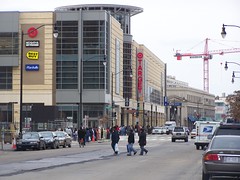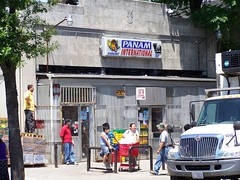Urban questions deserve urban answers
One of the primary reasons I am writing less in the blog is because to some extent I am bored. I say the same things over and over and over again. While over time there is a greater receptivity to the points, it becomes less interesting to me.
Such is the case with today's Washington Post article, "At NW Mall, So Many Spaces, So Little Need: D.C. Losing Millions On Empty Garage," about the overabundance of parking at the DC/USA shopping center in Columbia Heights.

DC/USA, 14th Street, Columbia Heights.
Been there, done that. I raised issues about the loan and excessive provision of parking for DC/USA, as well as the need to adopt broader transportation management practices back in 2004-2005, back before construction was starting, when things could have been changed.
I wrote this in response to the article on the columbia_heights e-list (with some editing and slight augmentations):
You will recall that this was discussed on this list by me (and others) way back when before the center was under construction. But it just isn't the issue of parking requirements. The developer could have gotten a zoning variance to create less parking.
The issue is that the tenants (especially Target) have heuristics about how shoppers get around and they therefore impose requirements about parking (among other conditions) on developers as a condition of their agreement to sign a lease. They mention this indirectly in the article.
So the energies were directed to satisfying those conditions, although they weren't disclosed publicly to the likes of us.
At the time, I kept bringing up the point that the extremely limited parking at the Tenleytown "Sears" for Container Store and Best Buy was adequate for their needs. (There are 150 underground parking spaces provided. Most of the time, fewer than half the spaces are in use, even during peak shopping periods.)
While the amount of s.f. dedicated to retail in DCUSA is significantly higher than at the Tenleytown location, DC/USA could still have been constructed with significantly less parking compared to industry norms, based on the experience in Tenleytown (which was discussed in a well attended presentation by Richard Lake of Roadside Development at the International Council of Shopping Centers regional meeting in DC in 2004 [it could have been 2003]).
Apparently the developer and the city did not try to challenge the assumptions of the tenants--which were based mostly on suburban experiences, not urban settings where people use transit--shall we not forget that the DCUSA center is built over the top of a subway station (just like Tenleytown)--and walk and bike (the bike racks are always full in front of the building, even if the parking garage is not) to shop.
And so you have this situation today, with a massive HUD loan to build the parking garage guaranteed by DC. A loan that isn't earning enough off parking fees to be paid off...

The District has lost nearly $2 million -- or $100,000 a month -- since the $40 million taxpayer-funded garage opened in March 2008. Many of the 1,000 spaces at the garage beneath the mall in Columbia Heights remain vacant. (By Marvin Joseph -- The Washington Post)
Instead in the article they say that now this is an example that can be used to convince developers to construct less parking. They had the evidence before.
Don't forget also my constant suggestions back then in discussions on this list for the tenants in DCUSA to offer a shared delivery service, which also would significantly reduce the need for driving to the shopping center. If such a service were expanded to include the Giant Supermarket, significant reductions in automobile trips to the Columbia Heights shopping district could result.
Note that itty bitty Pan Am International Super Market up a few blocks from these stores seems to manage to provide a delivery service for their customers. Certainly the tenants of DC/USA, combined with Giant, could do the same.

PanAm International Supermarket, 14th Street NW, Columbia Heights.
While it is true that this is an example of why the parking requirements should be changed in DC zoning requirements, IT IS ALSO AN EXAMPLE OF WHY TRANSPORTATION DEMAND MANAGEMENT PLANNING SHOULD BE ADOPTED AS A MATTER OF COURSE AS THE PLANNING PARADIGM GOING FORWARD*, the reality is that other things were going on there, other forces, and the few of us challenging that proposal were steamrolled by other stakeholders (including various agencies of the city government) wanting to show an environment completely supportive of what the retailers said they wanted, without countering that urban settings deserve urban solutions, not the suburban solutions national chain retailers are comfortable with and serve as their standard response and expectation.
(Note another issue with DC/USA was the initially supra-inadequate now just inadequate provision of bicycle parking/racks.)
------
* Note that the DC Office of Planning has thus far rejected amendments to the Comprehensive Plan proposing that transportation demand management planning requirements be included.
This is a perfect example of how limited planning and zoning perspectives yield very costly poor decisions--in this case a $40 million loan is not earning enough money to make the monthly payments. Plus it meant that space needed to be devoted to parking which instead could have been used for other more profitable uses.
------
Here are some emails on the columbia_heights e-list from 2004 on the subject:
Labels: commercial district revitalization, formula retail, parking and curbside management, transit, transportation planning, urban design/placemaking, urban revitalization



0 Comments:
Post a Comment
<< Home